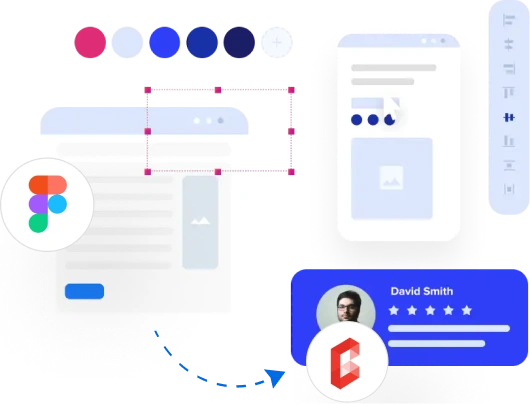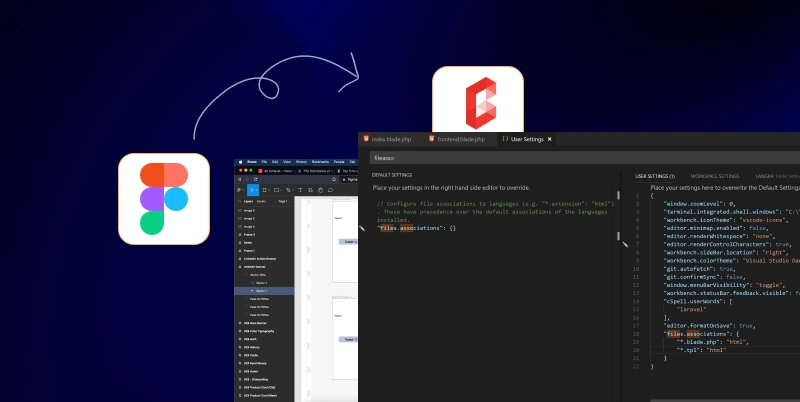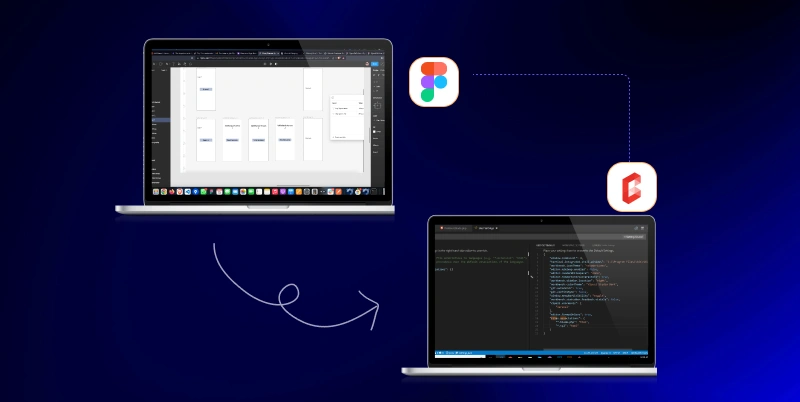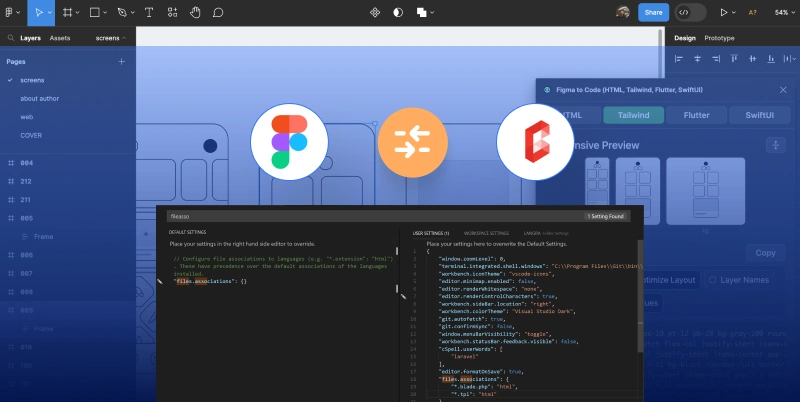
Figma to Laravel Blade conversion bridges design and backend views. Our services help you turn clean UI mockups into reusable Blade templates that work perfectly in any Laravel setup.
Transform your Figma designs into clean Laravel Blade templates that maintain visual integrity. We handle the conversion process with attention to detail, ensuring your web app looks exactly like the approved designs.
Break complex Figma components into reusable Blade components for consistent use across your project. Our developers extract these elements systematically, creating a library that matches your design system perfectly.
Configure Laravel Mix to properly compile all assets from your Figma files with optimized bundling. We set up proper SCSS variables, JavaScript components, and image optimization pipelines that reflect your design tokens.
Convert static Figma UI sections into dynamic Blade templates with proper inheritance and section yielding. The refactoring process preserves visual elements while implementing Laravel’s powerful templating features for better maintainability.
Implement custom authentication screens from Figma directly into Laravel’s auth scaffolding. We convert your unique login, registration, and password management interfaces while maintaining full compatibility with Laravel’s authentication system.
Build flexible content blocks in Blade that dynamically display data while preserving your Figma designs. Our templates include proper loops and conditionals that work seamlessly with Laravel’s Eloquent models and controllers.
Enhance your templates with custom Blade directives that bring Figma interactions to life. The integration includes creating specialized functionality beyond basic HTML conversion to add Laravel-specific templating power.
Verify your Figma to Laravel Blade conversion displays perfectly across all major browsers and devices. We conduct thorough compatibility testing to ensure consistent appearance and functionality throughout your application.
Keep Blade templates in sync with evolving Figma designs through ongoing support. Our maintenance includes implementing design updates, optimizing template performance, and ensuring compatibility with newer Laravel versions.
Experience faster development with Blade templates made from your Figma designs.

Our Figma to Laravel Blade conversion services are ideal for businesses looking to speed up development, maintain clean code, and convert custom designs into flexible Laravel Blade components.
If you’re handling multiple client projects and need support with front-end development, we’re here to help. Our team converts your Figma designs into clean Laravel Blade templates that are ready to plug into your backend. With our help, your agency can speed up delivery timelines, reduce internal load, and offer high-quality UI output that works perfectly across devices.

Big agencies require speed, scale, and coding consistency. Our team handles high-volume Figma to Laravel Blade conversions with strict quality checks and version control. This removes bottlenecks in frontend production and keeps large projects moving without delay. Each design element is coded to match Laravel’s structure, ensuring everything fits seamlessly into the project workflow.

Marketing teams offering web development as part of their services can rely on us for accurate design-to-code conversion. We turn marketing-driven Figma layouts into responsive Blade templates that follow SEO-friendly structure and load quickly. This allows marketing agencies to offer full Laravel-based websites that support better traffic, performance, and user experience.

Bringing your Figma visions to life within the robust Laravel framework demands technical understanding and a commitment to quality.
We foster a transparent and efficient conversion process, keeping you informed at every stage. Our clients appreciate our clear communication and the seamless transition from design to fully functional Laravel Blade templates.

We help you ensure clean, well-structured, and maintainable Laravel Blade code from your Figma files.
This guide walks you through the full process of converting Figma designs to Laravel Blade, with tips and what to expect at each step.

Converting your Figma designs to Laravel Blade can give your business a real development edge. It keeps the process fast, clean, and scalable. Here’s how it helps:
1. Faster Development Time
Figma to Laravel Blade conversion helps your developers work with ready-to-use Blade templates. They don’t need to start from scratch. The structure is already clean and modular.
2. Better UI Consistency
When you convert Figma designs to Laravel Blade, your front-end looks exactly like what your designers built. That means fewer layout issues and a consistent user experience.
3. Reusable Blade Components
Laravel Blade lets you reuse UI parts like headers, footers, or cards. So once you convert your Figma design to Laravel Blade, you can keep reusing parts and save time.
4. Easier Maintenance and Scaling
Using Blade with Figma designs makes updates simpler. When your UI changes in Figma, it’s easy to update just that part in Blade.

Blade is the templating engine that comes with Laravel. It lets developers build clean and reusable front-end code. When converting Figma designs to Laravel, Blade plays a big part in turning UI into real, working templates.
Why Blade Matters in Figma to Laravel Blade Conversion
Figma gives you the visual design. Blade helps you turn that design into something that runs inside Laravel. It’s fast, flexible, and great for front-end and back-end teams.
Here’s what Blade brings to the table:
How It Helps Businesses
When we convert Figma designs to Laravel, we don’t just slice the design. We build Blade files that match your workflow. This means:

A good design handoff makes Figma to Laravel Blade conversion much faster and more accurate. This checklist helps designers and developers work better together when turning Figma designs into working Laravel Blade templates.
1. Organize Your Figma Files
Before starting any Figma to Laravel Blade conversion, make sure your design files are well-organized:
2. Define Component Structure
Identify which parts of your design should become reusable Blade components:
3. Prepare Design Tokens
Export design tokens from Figma that will become variables in your Laravel Blade templates:
4. Document Interactions
Clearly explain how interactive elements should work:
5. Provide Design Assets
Export all necessary images and icons that will be needed in the Laravel project:

Once you convert Figma designs to Laravel, the next important step is optimization. Clean and fast Laravel Blade templates make your site work better for all users. Here’s how we keep your Blade files light and fast during and after Figma to Laravel Blade conversion.
1. Break Views Into Smaller Components
We split your UI into reusable parts.
This makes updates easier and reduces repeated code.
2. Use Blade Layouts
We use a master layout file that includes shared parts like navigation and scripts. Other pages just extend it. This improves load speed and keeps the structure neat.
3. Remove Unused Code
Unused CSS, scripts, or comments slow things down. We clean up everything during the Figma to Laravel Blade process so you don’t carry extra weight.
4. Use Laravel’s @once and @push
Blade has helpful features to control scripts and styles.
These tricks reduce conflict and improve page load.
5. Cache Blade Views
Laravel automatically compiles Blade files. We make sure this works right to speed up your site after the Figma to Laravel Blade conversion.

Finding the right partner for your Figma to Laravel Blade conversion project is a critical decision. Not all development teams have the specific skills needed to handle this specialized process well.
1. Technical Expertise
Look for a team with deep knowledge in both Figma and Laravel Blade:
2. Portfolio Review
Ask to see examples of past Figma to Laravel Blade conversion projects:
3. Development Approach
The right partner will have a clear process for Figma to Laravel Services:
4. Communication Style
Good communication makes Figma design to Laravel Blade projects run smoothly:
5. Timeline & Budget Clarity
A trustworthy partner will be upfront about project details:
Do you have questions about our Figma to Laravel Blade services? Here’s everything you need to know before getting started.
The time it takes to convert Figma to Laravel Blade depends on the design complexity and how many screens you have. We start fast, keep you updated, and deliver as early as possible.
To convert Figma designs to Laravel Blade, we’ll need:
The more details you share, the smoother the process.
Figma to Laravel Blade conversion costs depend on your design size and complexity. It varies based on the number of screens, UI interactions, and development preferences. We’ll share a clear and honest quote once we review your Figma file and requirements. There are no surprise charges, and everything is discussed before we begin.
Yes, we include clean documentation with every Figma to Laravel Blade project.
It covers:
You won’t need to guess where anything goes.
Always. Every Figma to Laravel service we offer is built on Laravel’s latest standards.
We use Blade directives smartly, keep code modular, and follow clean naming patterns for layouts, partials, and sections.
Yes. If your Figma designs change after we start, we can update the Blade templates accordingly. We support version-controlled updates and ongoing tweaks as part of our Figma to Laravel services.
Let us show you how our digital services can drive your success.